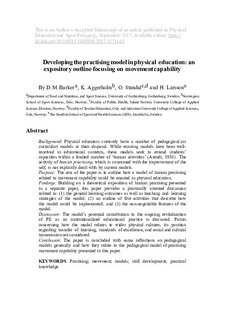Developing the practising model in physical education: an expository outline focusing on movement capability
Peer reviewed, Journal article
Accepted version
Permanent lenke
http://hdl.handle.net/11250/2589119Utgivelsesdato
2017Metadata
Vis full innførselSamlinger
Sammendrag
Background: Physical educators currently have a number of pedagogical (or curricular) models at their disposal. While existing models have been well-received in educational contexts, these models seek to extend students’ capacities within a limited number of ‘human activities’ (Arendt, 1958). The activity of human practising, which is concerned with the improvement of the self, is not explicitly dealt with by current models. Purpose: The aim of the paper is to outline how a model of human practising related to movement capability could be enacted in physical education. Findings: Building on a theoretical exposition of human practising presented in a separate paper, this paper provides a practically oriented discussion related to: (1) the general learning outcomes as well as teaching and learning strategies of the model; (2) an outline of five activities that describe how the model could be implemented; and (3) the non-negotiable features of the model. Discussion: The model’s potential contribution to the ongoing revitalization of PE as an institutionalized educational practice is discussed. Points concerning how the model relates to wider physical cultures, its position regarding transfer of learning, standards of excellence, and social and cultural transmission are considered. Conclusion: The paper is concluded with some reflections on pedagogical models generally and how they relate to the pedagogical model of practising movement capability presented in this paper.
